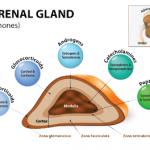So far a minimal daily dose of 75 to 100 mg seems required, and sometimes such a dose does not entirely control symptoms and sedimentation rates. Perhaps small doses will be sufficient in cases in which the disease is mild.
Dr. Bucala notes that this therapeutic dose is roughly equivalent to a dose that might be used to manage an initial disease flare today (e.g., using the closely related synthetic glucocorticoid prednisone).
Theory & Speculation
The authors used their findings to speculate further on alternative theories to what they call the microbic theory, asking:
To what extent could rheumatoid arthritis be merely a syndrome produced by any factor which causes a deficiency of adrenal hormone?
“There are limits of that thinking that are obvious now today,” says Dr. Burns. “Immunology has advanced so much, and we know now that an infection can trigger long-term immune response, and you’d expect that to respond to steroids. But back then it was very novel thinking.”
Dr. Bucala also points out that although today we know that inflammatory diseases are not deficiencies of adrenal gland steroids per se, the pain and inflammation of these diseases does cause a stress response that results in relative adrenal deficiencies.
Drs. Hench and Kendall concluded by speculating that compound E might be helpful in other rheumatic and non-rheumatic medical conditions, particularly other conditions that Dr. Hench had previously described as sometimes going into remission during liver disease or pregnancy. They also reported that their preliminary results in a patient with systemic lupus erythematosus were “encouraging.”1
Yet Drs. Hench and Kendall were careful to balance the optimism of the paper with caveats. They noted the practical challenges around compound E’s availability, which posed a significant barrier to ongoing investigation. They also remarked on the limited scope of this preliminary data, especially with respect to long-term use.
[This] make [s] inappropriate now the use of the term “treatment” except in an investigative sense. Much more experience is needed before we shall know how effective or safe the prolonged administration of compound E will be.
Public Response
In spite of this cautionary approach, compound E, soon renamed cortisone by Drs. Hench and Kendall, quickly captured the public’s attention.
In 1950, Dr. Hench, Dr. Kendall and Polish chemist Tadeus Reichstein, PhD (who had worked separately in Switzerland to isolate adrenal compounds), were awarded the Nobel Prize in physiology or medicine, just two years after Mrs. G received her first injection.3 In his acceptance speech, Dr. Hench reported that the compound decreased symptoms in most patients with RA, gout, lupus, psoriasis and ulcerative colitis.4

